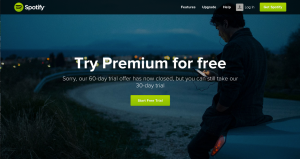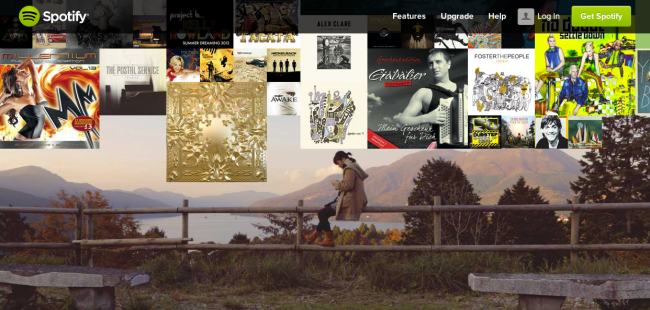A free what!? (The offer)
Spotify launched an amazing offer in early November where users are able to download a free 60 day trial of Spotify Premium. Recently, that offer has been reduced to a free 30 day trial of Premium, but I still say that’s better than no trial at all! Spotify has 3 different levels of their radio available: Free, Unlimited and Premium. Every user starts with the Free version which means instant, free music with advertisements (played in between songs) to your laptop or desktop. You can create playlists and star music that you like and that you want to hear again (but only from a laptop or desktop) You cannot access your playlists or starred music on a mobile device. With mobile, the free app allows you to play Spotify radio (which is where you don’t choose specific songs to hear–it becomes more like Pandora.) A user may upgrade to Spotify’s Unlimited version which costs $4.99/month and is the same thing as the free version but without advertisements. And then there’s Spotify’s Premium version which costs $9.99/month and you can listen to all your playlists, starred music lists on all your devices, there are no advertisements. For both Unlimited and Premium, you can decide to end your upgrade whenever you like, there’s no commitment which is pretty nice and considerate of Spotify.
How do you get this awesome deal? (content of the e-mail)
I got an e-mail from Spotify radio in late October that was titled “Redeem your free 60 days of Premium now!” Spotify then personalized their message/ad by addressing me directly, reading “Hi Monica, can we tempt you back with 2 free months of Premium? This is our best offer ever and it’s on for a limited time…you’ll need to redeem by Sunday, November 3rd.” Then it went on to list all the benefits I would get by upgrading. This offer is available for any and all who use or simply know about Spotfiy but this offer was exclusively advertised to Spotfiy users who are already on Spotify’s e-mail list serve (to get on their list serve, you simply create a Spotfiy account.)
Why launch this awesome deal? (Spotfiy’s target audience & effectiveness of offer/strategy)
This offer most likely done for measurability, to increase revenue, to have and keep Spotify users in the know of the latest news and to actually get their trial used by already established users. I think this offer was a great promotion for Spotify to do as they do have competitors (Pandora, 8tracks… etc) who are not offering free trial upgrades at the moment. This offer was not only targeting their current users but also targeting more/new users who may not know the exact differences between Spotify and their competitors. When curious, potential users visit spotify.com, scroll down, they are able to see the 3 different levels of Spotify radio and how there is a promotion for a free trial of Premium. If anything, this offer is effect as it definitely acts as an incentive for unsure radio deciders to go with Spotify. Spotify will also most likely accomplish one of their goals of generating more revenue. The users that do upgrade their accounts with the free trial of Premium have to keep in mind that once their 30 (or 60) free days are up, they are responsible for canceling their Premium upgrades or else they will be billed $9.99 per month until they do so. And Spotify has to know that there will always be those users who aren’t good at keeping track of their free days. Continue reading


